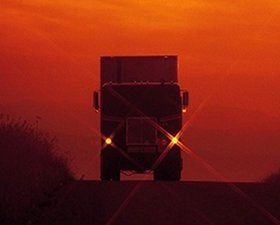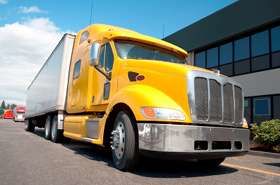Doubles And Triples
Topic 12381 | Page 1

It's not hard at all. Especially if both trailers are pups. If you watch what happens in the mirror, when the first trailer straightens out behind you, it pulls the next trailer forward and away from the object you are attempting to miss. It was kinda cool watching that for the first time then realizing what it was doing.

Pat's right.
I pull doubles all the time. You can make much tighter turns with doubles. When you look in your mirror and see your dolly wheel under the front of the tail pup trailer, that's about where your pivot point is for your turn. Meaning, you'll clear your tail trailer even though it might appear that you won't. It's almost like turning the set at a 90 degree angle if that makes any sense.
In regard to how they handle, the main difference you gotta watch for compared with a van is how much they can wiggle - hence their moniker "wiggle wagons." The weight distribution from the freight can make a world of difference between an easy / smooth pulling set and a set that feels like it's fighting you and every wind and turn.
Also, it's extremely difficult to back them up. Not impossible, but takes A LOT of practice and the actual backing up maneuver takes some time to do.
Pre-tripping a set takes more time because there are more things to watch for compared with just hooking up to a van. It's all about routine. Get yourself into a routine where you do the same thing over and over again, and you won't miss a step when hooking or dropping a set.
It's probably because I'm used to it, but I prefer to pull doubles.
Doubles:
Refers to pulling two trailers at the same time, otherwise known as "pups" or "pup trailers" because they're only about 28 feet long. However there are some states that allow doubles that are each 48 feet in length.
Pat's right.
I pull doubles all the time. You can make much tighter turns with doubles. When you look in your mirror and see your dolly wheel under the front of the tail pup trailer, that's about where your pivot point is for your turn. Meaning, you'll clear your tail trailer even though it might appear that you won't. It's almost like turning the set at a 90 degree angle if that makes any sense.
In regard to how they handle, the main difference you gotta watch for compared with a van is how much they can wiggle - hence their moniker "wiggle wagons." The weight distribution from the freight can make a world of difference between an easy / smooth pulling set and a set that feels like it's fighting you and every wind and turn.
Also, it's extremely difficult to back them up. Not impossible, but takes A LOT of practice and the actual backing up maneuver takes some time to do.
Pre-tripping a set takes more time because there are more things to watch for compared with just hooking up to a van. It's all about routine. Get yourself into a routine where you do the same thing over and over again, and you won't miss a step when hooking or dropping a set.
It's probably because I'm used to it, but I prefer to pull doubles.
Do you back them often? Someone told me he never backs them jus drops rhem and the company yard jockeys get them. But that could just be his compnay
Doubles:
Refers to pulling two trailers at the same time, otherwise known as "pups" or "pup trailers" because they're only about 28 feet long. However there are some states that allow doubles that are each 48 feet in length.

Pat's right.
I pull doubles all the time. You can make much tighter turns with doubles. When you look in your mirror and see your dolly wheel under the front of the tail pup trailer, that's about where your pivot point is for your turn. Meaning, you'll clear your tail trailer even though it might appear that you won't. It's almost like turning the set at a 90 degree angle if that makes any sense.
In regard to how they handle, the main difference you gotta watch for compared with a van is how much they can wiggle - hence their moniker "wiggle wagons." The weight distribution from the freight can make a world of difference between an easy / smooth pulling set and a set that feels like it's fighting you and every wind and turn.
Also, it's extremely difficult to back them up. Not impossible, but takes A LOT of practice and the actual backing up maneuver takes some time to do.
Pre-tripping a set takes more time because there are more things to watch for compared with just hooking up to a van. It's all about routine. Get yourself into a routine where you do the same thing over and over again, and you won't miss a step when hooking or dropping a set.
It's probably because I'm used to it, but I prefer to pull doubles.
Do you back them often? Someone told me he never backs them jus drops rhem and the company yard jockeys get them. But that could just be his compnay
I don't have to back a set. I break the set or drop it. There's really no reason to back a set of doubles, unless you're at a truck stop or trying to impress somebody. Whenever most linehaulers go to truck stops, they're parking in a way that they dont' have to back up.
Linehaul:
Linehaul drivers will normally run loads from terminal to terminal for LTL (Less than Truckload) companies.
LTL (Less Than Truckload) carriers will have Linehaul drivers and P&D drivers. The P&D drivers will deliver loads locally from the terminal and pick up loads returning them to the terminal. Linehaul drivers will then run truckloads from terminal to terminal.Doubles:
Refers to pulling two trailers at the same time, otherwise known as "pups" or "pup trailers" because they're only about 28 feet long. However there are some states that allow doubles that are each 48 feet in length.

Hey 6 String I'm putting in a application Tuesday here in Atlanta for a P&D position, is there Anything about that position that you can tell me different than what they tell you online???
P&D:
Pickup & Delivery
Local drivers that stay around their area, usually within 100 mile radius of a terminal, picking up and delivering loads.
LTL (Less Than Truckload) carriers for instance will have Linehaul drivers and P&D drivers. The P&D drivers will deliver loads locally from the terminal and pick up loads returning to the terminal. Linehaul drivers will then run truckloads from terminal to terminal.

I agree with 6-string. And I'll happily take a set of doubles before a 48' van, any day.
Hi, I've worked P&D for a year and it is very different from linehaul in abstract and concept. What are they "telling" you online?
-mountain girl

P&D:
Pickup & Delivery
Local drivers that stay around their area, usually within 100 mile radius of a terminal, picking up and delivering loads.
LTL (Less Than Truckload) carriers for instance will have Linehaul drivers and P&D drivers. The P&D drivers will deliver loads locally from the terminal and pick up loads returning to the terminal. Linehaul drivers will then run truckloads from terminal to terminal.
Linehaul:
Linehaul drivers will normally run loads from terminal to terminal for LTL (Less than Truckload) companies.
LTL (Less Than Truckload) carriers will have Linehaul drivers and P&D drivers. The P&D drivers will deliver loads locally from the terminal and pick up loads returning them to the terminal. Linehaul drivers will then run truckloads from terminal to terminal.Doubles:
Refers to pulling two trailers at the same time, otherwise known as "pups" or "pup trailers" because they're only about 28 feet long. However there are some states that allow doubles that are each 48 feet in length.

Cool, their telling me about entering and exiting the cab as many as 45 times a day but will this be going to residential locations are will it be from business buildings to business buildings and it says that I'll be doing 11 hrs of driving. Is this what you do Mountain Girl?
New Reply:
New! Check out our help videos for a better understanding of our forum features

















Preview:








 TT On Facebook
TT On Facebook
So at my curreny job I'm a route delivery driver and I'm considering getting my d/t endorsement and just wondering how hard it is to drive with doubles
Doubles:
Refers to pulling two trailers at the same time, otherwise known as "pups" or "pup trailers" because they're only about 28 feet long. However there are some states that allow doubles that are each 48 feet in length.